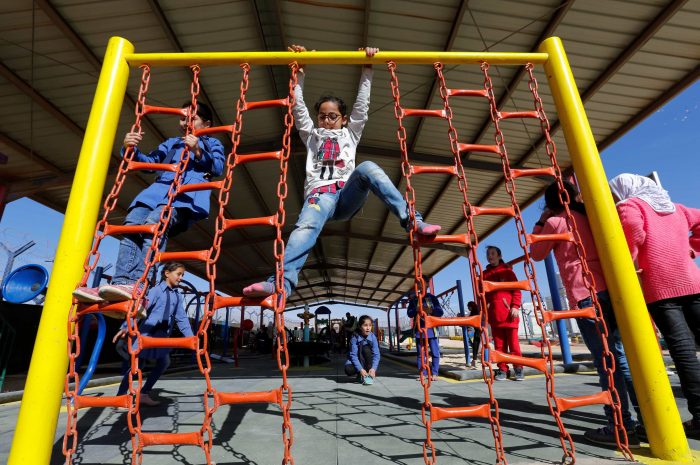Civil Society for the Displaced
To meet the challenges of massive human displacement in the Middle East and North Africa, civil society actors need a common platform where they can advocate. The MENA Civil Society Network for Displacement or CSND sets out to be that.

Syrian refugee children play at a new park designed also for people with various physical disabilities in the Al-Zaatari refugee camp, in the Jordanian city of Mafraq, near the border with Syria, November 27, 2018. Muhammad Hamed/Reuters
The Middle East and North Africa (MENA) has been experiencing displacement on a massive scale for decades, and is now witnessing the largest amount of humanitarian crises in contemporary regional history. Wave after wave of conflict-induced refugee and internal displacement movements have taken place in many countries across the region. Addressing the complex set of current challenges and planning for post-conflict stabilization are high on the agendas of many stakeholders internationally. Yet, the brunt of the responsibility to provide protection and assistance to those fleeing conflict and violence continues to be borne by the MENA region, with almost 40 percent of total global displacement contained within the Middle East and North Africa.
How has the region dealt with these movements? How have local actors, first line responders, national NGOs, faith-based organizations, academics, media, community-based organizations, and so many others composing what we consolidate together as “civil society” worked together? How can they more coherently work toward building structures and measures which have a sustainable and preventive impact?
Urbanization, unemployment, deepening economic disparities, poverty, gender inequality, sectarianism, the rising threat of extremism, and fragmentation continue to challenge many countries across the Middle East and North Africa. Yet, a longstanding and well-established cultural and historic legacy of providing aman (safety) for those fleeing their homes and seeking refuge remains an integral part of the public’s attitude. Unprecedented demonstrations of hospitality and compassion unfolded during the beginning of the Syria crisis, and despite the protracted nature of the situation in that country, outpourings of goodwill continue. Building on this hospitality, however, more predictable, sustainable, and comprehensive responses are essential, which take into full account the impact on host countries.
Pioneering Innovation CSND Style
Civil society actors in the MENA region have played a critical role in responding to refugee crises despite the challenges posed by the fluctuating regional context since 2011. Whether through the largest regional mobilization of students and faculty in the form of the initiative entitled #AUB4Refugees in Lebanon, which garnered attention, advocacy, and support for refugees in a highly sensitive and challenging environment, or through networks of Jordanian entrepreneurs who employ and capacitate refugee women, local actors have been the first responders, and the most closely connected to developments and the needs of displaced persons and their host communities.
To capitalize on this resource, the United Nations High Commissioner for Refugees (UNHCR) convened national and regional actors in December 2016 to establish the MENA Civil Society Network for Displacement (CSND), in order to provide a platform for civil society to work on refugee responses.
The CSND preceded the formal adoption of the Global Compact on Refugees, which emerged out of the landmark New York Declaration for Refugees and Migrants signed by all 193 Member States of the United Nations in September, 2016. Adopted by 181 countries in the UN General Assembly in December 2018, the Global Compact on Refugees provides a unique opportunity to strengthen the international response to large movements of refugees and protracted refugee situations. Its four key objectives are to: ease the pressures on host countries; enhance refugee self-reliance; expand access to third-country solutions; and support conditions in countries of origin for return in safety and dignity.
The uniqueness of the CSND initiative has been that it connects with diverse actors who are part of a large geographic area. The CSND provides a common platform for its partners—including non-governmental and community organizations, philanthropic groups, think tanks, universities, businesses, media networks/personalities, faith-based organizations, and others—to advocate collectively from. The aim of the CSND has been to strengthen its partners’ voices through aligned messaging, joint advocacy, training, and coordinated interventions.
Under the network, a sub-group of academics and researchers has been established to develop a knowledge base in Arabic on displacement issues which can feed into more evidence-based policy-making. The CSND network is also developing more structured engagement with local and regional private sector actors to build on their technical expertise and leverage their expanding engagement in the region to include protection advocacy, generating employment opportunities, making the case for wider contributions from refugees in labor markets, and making linkages with national development plans. Working towards finding comprehensive solutions which help refugees thrive, not just survive, requires full understanding of national priorities and sensitivities, and the voices of local actors are therefore critical.
A consultative process paved the way for full engagement with the needs of civil society actors in the region. With six regional and sub-regional consultations held with partners from North Africa, the Middle East, and the Gulf Cooperation Council countries, two regional academic roundtables, five webinars, the first regional convening of business women and refugee women entrepreneurs, and the first regional joint advocacy campaign, reaching over 200 partners, a more granular analysis of the core challenges and opportunities has been developed.
Aspirations Forward
MENA region CNSD members have shown their commitment to addressing the full cycle of displacement from prevention, to immediate response, to solutions. The network is currently discussing common approaches to key protection priorities, including policy frameworks, solutions, and social cohesion. Distinctions in approach have begun to emerge among the sub-regions, with a strong emphasis on legal systems in North Africa; the need for more development and infrastructure support in the Middle East; and building on philanthropic interests in the Gulf.
As we move forward in implementing the principles of the New York Declaration, the Global Compact on Refugees is a unique opportunity to strengthen the international response to protracted refugee situations. Its objectives build on the collective recognition that humanitarian assistance and protection must be delivered differently, with long-term visions kicking in at an earlier stage of response, and aligned with sustainable development goals at the national level for host countries.
For a truly comprehensive, predictable, and sustainable “whole society” approach to displacement, the voices of local and national stakeholders and private sector actors in the MENA region need to be better integrated with the UN’s response and be included in the thinking about the developmental priorities of the region. Hopefully the CNSD can contribute to that.
The views expressed in this article do not necessarily represent the views of any organization the author may be affiliated with.



